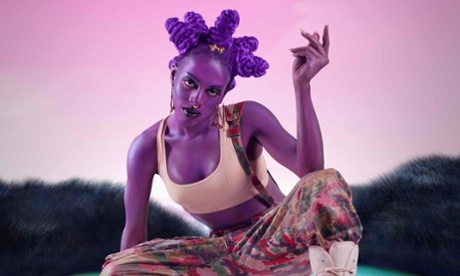For the first time, the Museum of Modern Art in New York and Performa, the performing art biennial that celebrates its 10th anniversary this month, have joined together to co-commission a work. The inspiration for the collaboration is Juliana Huxtable, the transgender artist, DJ and downtown personality who will stage two performances of the new work, There Are Certain Facts That Cannot Be Disputed, on 13 and 14 November in New York.
Huxtable is “a key voice in New York’s art world, and a catalyst for other artists, writers and performers in the city,” says Stuart Comer, MoMA’s chief curator of media and performance art. Huxtable was one of the breakout stars of this year’s New Museum Triennial, in which she appeared as both muse and maker: a hyper-real, 3D printed sculpture of her naked body by artist Frank Benson was the exhibition’s showstopper, displayed near a selection of self-portraits and poems by Huxtable herself.
Born intersex into a conservative Baptist family in Texas, Huxtable was assigned male at birth and raised as a boy named Julian Letton. As the only black student in her school, she was bullied. She always kept a diary and made drawings, and has said that her paintings from this period were troubled. Puberty was rough, her breasts growing in tandem with her parents’ sense of denial and her own sense of isolation.
After moving to upstate New York for a bachelor’s degree at Bard College, Huxtable gradually began to reimagine herself. Encouraged by the House of Ladosha, the queer arts collective she belongs to, she changed her name in a nod to the “respectability politics” of her parents’ generation, as represented by television’s fictional Cosby family. “There was a lot of worshipping of black patriarchs at that time. Bill Cosby represented the idea of an intense but relatable symbol of power,” she says. As to whether her name means something different now, in the wake of the Cosby rape scandal, Huxtable exhales a long “ooh”. She pauses: “I hadn’t thought of it – but all the other aspects of that fantasy are dissolving as well.”
The erosion of fantasies and the question of who holds power form the thrust of Huxtable’s Performa piece. She wants to look at our human desire to locate ourselves within history – to explore a particular time or place with which we somehow identify – something she felt acutely as a teenager. “By making an association with a country or an idea, there’s this participatory power. You ground yourself in a sense of history, an expansive idea of what you signify,” she says.
The idea for the work came about through conversations with Comer and Adrienne Edwards, a curator at Performa, and a piece of writing Huxtable did around 20 months ago. It is written like Huxtable talks – in a fast-flowing, rhythmic burst of ideas – and concerns histories (“older, whiter versions of ‘the man’ past’”) that the artist has been locked out of, her “black member” betraying “any claim to a legacy-based” past.
The Performa commission will comprise three chapters. The first deals with the motivations for locating oneself in history, especially in finding alternative versions therein, “like an obsession with rereading medieval history to find a feminist history”, Huxtable says. “It’s that desire to find anchor points and say ‘There. This is my connection to that.’”
The second is how that desire manifests in the information age, how history is assembled and abandoned in cyberspace. The internet was presented as a utopian alternative to books, a place where everyone could publish and access information for free. But, the “fantasy has been revealed as a fantasy”, Huxtable says. The web has instead turned history into a flimsy, ephemeral thing easily erased with one bounced URL or wiped Google cache.
Huxtable cites the Encyclopedia Africana as an example, which was conceived as the realisation of scholar WEB Du Bois’s vision of a counterpart to the Encyclopedia Britannica that would be “unashamedly Afrocentric, but not indifferent to the impact of the outside world”. Created by Kwame Anthony Appiah and Henry Louis Gates Jr, the book was first published in 1999 and was “seen as really radical when it first came out, this necessary gesture. It was one of the biggest pursuits of the time”, Huxtable says.
The volume was last published in 2005, after which it was “transferred online because the publishing industry surrounding encyclopedias died”, Huxtable says. “Then they just stopped the website because they couldn’t compete with Wikipedia. They just stopped publishing it, period. All those kinds of sites have died. These textual anchor points have been pushed out, but now what do you instead? Wikipedia?”
This chapter of the performance deals with Huxtable’s sense of frustration and mourning about the internet’s “transition to something like an oligarchy … The idea of people’s personal information being controlled goes hand in hand with this access to history – the two things are determined by Google algorithms. And if a server is not renewed, then it’s gone for good”.
The final chapter deals with the kinds of small online communities of which Huxtable is a part, and the way that information is now more visual than textual. “There’s a freedom that comes with that,” she says. These sites “carry a lot of power ... For me, the power I needed when I was 14 and wanted to be grounded in a history, is there”.
Referring to a Tumblr that documents people of colour in western art history as an example, Huxtable says sites like this “signify far more than someone writing an essay about pre-colonial African history”.
Her Performa work will be realised with a collaborative consortium of sound, lighting, music, video and laser projection artists. This is typical of Huxtable’s way of working: “I feel like my growth is based directly on the people who have supported me – it’s not an isolated effort.” Her work is, she says, “a natural product of everything I do. I would feel weird working with a bunch of people I don’t know”.
It’s this collaborative, fluid approach to culture, music and history which has allowed Huxtable to become a sort of lightning conductor for her peers. With her Performa piece, she is allowing others who have been overlooked or discarded by history to come along with her for the ride, right into the centre of the contemporary art scene and, indeed, into the middle of a museum about the history of art itself.
- Juliana Huxtable’s There Are Certain Facts That Cannot Be Disputed is at MoMA, New York on 13 and 14 November. Details here








